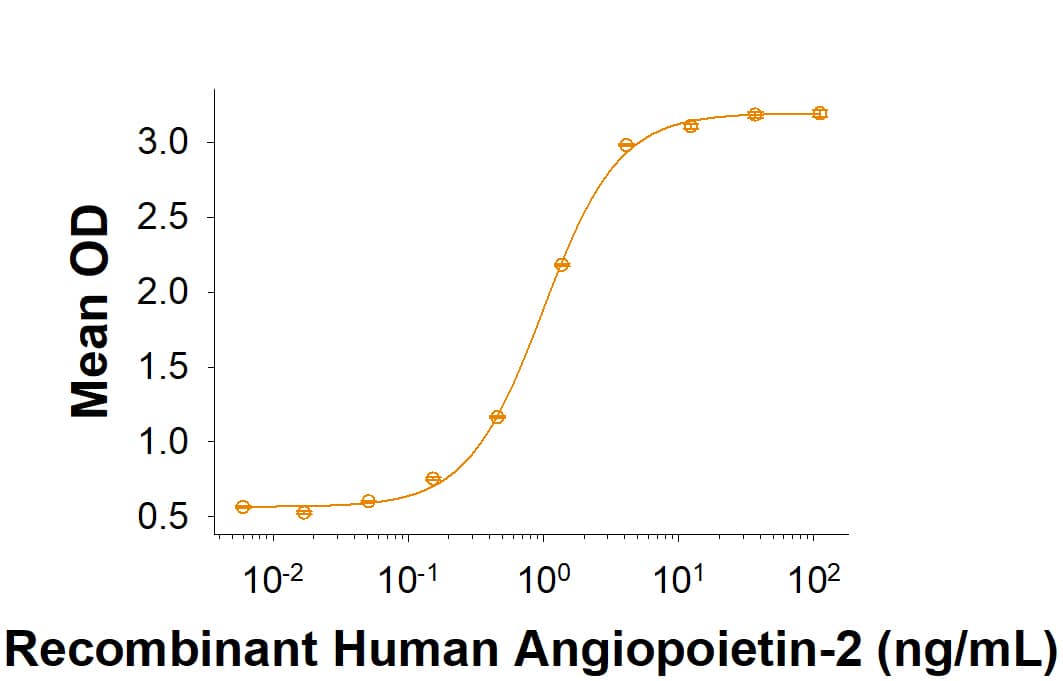Recombinant Canine Tie-2 Fc Chimera Protein, CF
R&D Systems, part of Bio-Techne | Catalog # 10720-T2

Key Product Details
Source
NS0
Accession #
Structure / Form
Disulfide-linked homodimer
Conjugate
Unconjugated
Applications
Bioactivity
Product Specifications
Source
Mouse myeloma cell line, NS0-derived canine Tie-2 protein
| Canine Tie-2 (Ala23-Lys746) Accession # XP_005626754.1 |
IEGRMD | Human IgG1 (Pro100-Lys330) |
| N-terminus | C-terminus |
Purity
>95%, by SDS-PAGE visualized with Silver Staining and quantitative densitometry by Coomassie® Blue Staining.
Endotoxin Level
<0.10 EU per 1 μg of the protein by the LAL method.
N-terminal Sequence Analysis
Ala23
Predicted Molecular Mass
107 kDa
SDS-PAGE
115-135 kDa, under reducing conditions
Activity
Measured by its binding ability in a functional ELISA.
When Recombinant Canine Tie-2 Fc Chimera (Catalog # 10720-T2) is immobilized at 0.5 µg/mL (100 µL/well), Recombinant Human Angiopoietin-2 (Catalog # 623-AN) binds with an ED50 of 0.40-3.60 ng/mL.
When Recombinant Canine Tie-2 Fc Chimera (Catalog # 10720-T2) is immobilized at 0.5 µg/mL (100 µL/well), Recombinant Human Angiopoietin-2 (Catalog # 623-AN) binds with an ED50 of 0.40-3.60 ng/mL.
Scientific Data Images for Recombinant Canine Tie-2 Fc Chimera Protein, CF
Recombinant Canine Tie-2 Fc Chimera Protein Binding Activity.
When Recombinant Canine Tie-2 Fc Chimera (Catalog # 10720-T2) is immobilized at 0.5 µg/mL (100 µL/well), Recombinant Human Angiopoietin-2 (623-AN) binds with an ED50 of 0.40-3.60 ng/mL.Recombinant Canine Tie-2 Fc Chimera Protein SDS-PAGE
2 μg/lane of Recombinant Canine Tie-2 Fc Chimera (Catalog # 10720-T2) was resolved with SDS-PAGE under reducing (R) and non-reducing (NR) conditions and visualized by Coomassie® Blue staining, showing bands at 115-135 kDa and 230-270 kDa, respectively.Formulation, Preparation and Storage
10720-T2
| Formulation | Lyophilized from a 0.2 μm filtered solution in PBS with Trehalose. |
| Reconstitution | Reconstitute at 500 μg/mL in PBS. |
| Shipping | The product is shipped at ambient temperature. Upon receipt, store it immediately at the temperature recommended below. |
| Stability & Storage | Use a manual defrost freezer and avoid repeated freeze-thaw cycles.
|
Background: Tie-2
References
- Zhang, Y. et al. (2019) iScience. 20:497
- Eklund, L. and Saharinen, P. (2013) Exp Cell Res 319:1271.
- Seegar, T.C.M. et al. (2010). Molec Cell. 37: 643.
- Barton, W.A. et al. (2006). Nat Struc & Molec Biol. 13:524.
- Findley, C.M. et al. (2007) Arterioscler Thromb. Vasc. Biol. 12:2619.
- Huang, H. et al. (2010) Nat. Rev. Cancer 10:575
- Saharinen, P. et al. (2005) J. Cell Biol. 169:239.
- Leppanen, V. et al. (2017) PNAS. 114:4376.
- Song, S. et al. (2012) Biochem and Biophy Res. Comm. 419:281.
- Saharinen, P. et al. (2017) Nat. Rev. Drug Discov. 16:635.
- Grenga, I. et al. (2015) J. Immunotherapy Cancer 3:52.
Long Name
Tyrosine Kinase with Immunoglobulin and Epidermal Growth Factor Homology Domains 2
Alternate Names
CD202b, TEK, Tie2
Entrez Gene IDs
Gene Symbol
TEK
UniProt
Additional Tie-2 Products
Product Documents for Recombinant Canine Tie-2 Fc Chimera Protein, CF
Product Specific Notices for Recombinant Canine Tie-2 Fc Chimera Protein, CF
For research use only
